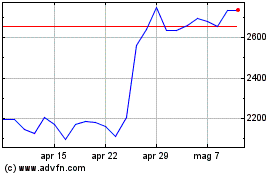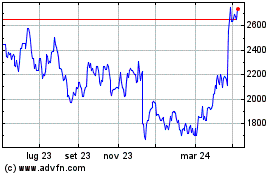By Alexandra Wexler
ORAPA, Botswana -- De Beers is facing up to a tough reality: The
world's diamond deposits won't last forever.
The mining behemoth, a unit of Anglo American PLC, is rewriting
its century-old playbook as discoveries of new diamond troves grow
scarce and its aging mines become more costly to operate. Global
diamond production is falling, companies and analysts say, pushing
De Beers to make investments and strategic changes that were almost
unthinkable a few years ago.
The former monopoly famed for secrecy is developing a
traceability system to verify a diamond's provenance, a bid to
attract more socially conscious buyers. De Beers also stunned the
industry last year with plans to sell its first synthetic diamonds
through a new subsidiary. The synthetic stones are identical to
natural stones in composition but are made in labs rather than
mined from the earth.
De Beers Chief Executive Bruce Cleaver said in a recent
interview that those changes and a new marketing push are necessary
to ensure diamonds remain a coveted purchase for Asia's expanding
middle class and American millennials reaching new life
milestones.
"We are standing on the cusp of a new diamond world," Mr.
Cleaver said. "It is a world...of considerable opportunity, if we
make the right choices."
De Beers, founded by a group including colonialist pioneer Cecil
John Rhodes in 1888, weathered the mothballing of its mines during
the Great Depression and the destruction of its London trading
offices in the Blitz during World War II.
As recently as the 1980s, De Beers controlled more than 80% of
the world's diamond supply. In 2012, Anglo American paid the
Oppenheimer family $5.1 billion for its 40% stake in the company,
which last year contributed about a quarter of global diamond
production.
That global industry is changing fast. During the most recent of
the regular diamond sales that De Beers conducts for buyers, the
company sold $390 million of rough diamonds, down 12% from the same
sale in 2018. Earnings before interest, taxes, depreciation and
amortization in the first half of this year dropped to $518
million, down 27% compared with the same period in 2018. Sales have
been hurt by a slowing global economy, the U.S.-China trade war,
protests in Hong Kong and tighter lending in India, where most
diamonds are cut and polished.
De Beers is ramping up an old standby, marketing, to help combat
the trends. The company is spending $180 million on marketing this
year, the most in a decade.
Another plank of De Beers' strategy is to boost supply chain
transparency by communicating the provenance and authenticity of
its diamonds, which are typically mixed together and sold to buyers
in bulk lots, effectively eliminating the ability to trace them
back to their origin.
"Consumers have been asking for proof of sustainable and ethical
sourcing," said Jim Duffy, chief executive of Tracr, a platform
that provides a diamond's provenance and traces it all the way
through the supply chain.
Using artificial intelligence and blockchain technology,
retailers will be able to show consumers that their diamond was dug
up in the sun-baked mining town of Orapa, in central Botswana,
where warthogs laze about the parking lots. Information on the
platform could explain whether proceeds from that stone funded a
particular road, school or hospital project. It could become as
granular as giving a consumer the back story of the specific person
who cut and polished the diamond, Mr. Duffy said.
Tracr goes beyond the Kimberley Process, the industrywide effort
to prevent insurgent groups from trafficking in rough diamonds by
certifying that stones are conflict-free. Tracr, initially an
in-house project at De Beers, is being spun out to the wider
diamond industry and is expected to launch commercially early next
year. It already has more than 30 participants, including De Beers
and Russia's PAO Alrosa, the world's largest diamond producer by
volume, and Chow Tai Fook Jewellery Group Ltd. of Hong Kong, the
world's second-largest jeweler.
"Increasing supply chain transparency is the industry's lowest
hanging fruit," said Paul Zimnisky, an independent diamond analyst
in New York.
De Beers has also staked a claim in the lab-grown diamond
market. That appears to have been a shrewd move. Since DeBeers said
it would sell synthetic stones under a brand called Lightbox, the
wholesale price for a 1-carat lab-grown stone has dropped from
near-parity with mined stones in some cases to about 60% below that
level. De Beers said they want consumers to see lab-made diamonds
as less precious than stones dug from the earth.
"There's no rarity: It's fashion, it's fun, it's lighthearted,"
Mr. Cleaver said.
Analysts expect natural diamond prices to stabilize following
their recent drop as global production continues to fall. Output is
projected to fall through at least 2021 as older mines are depleted
and new deposits aren't developed to replace them.
De Beers has sold several mines in recent years but is investing
heavily in those that remain.
In South Africa, De Beers is spending $2 billion to extend the
life of its single remaining mine there, Venetia, into the 2040s by
moving production from an open pit to underground.
And the company said in March it would spend another $2 billion,
together with the government of Botswana, to expand its largest
mine there. The investment should extend the life of that mine,
Jwaneng, to at least 2035.
Write to Alexandra Wexler at alexandra.wexler@wsj.com
(END) Dow Jones Newswires
November 30, 2019 05:44 ET (10:44 GMT)
Copyright (c) 2019 Dow Jones & Company, Inc.
Grafico Azioni Anglo American (LSE:AAL)
Storico
Da Mar 2024 a Apr 2024

Grafico Azioni Anglo American (LSE:AAL)
Storico
Da Apr 2023 a Apr 2024
